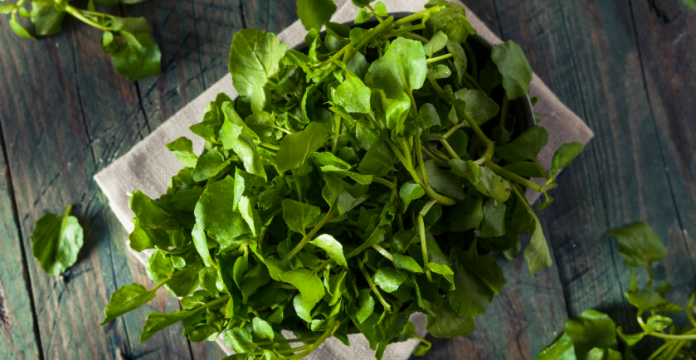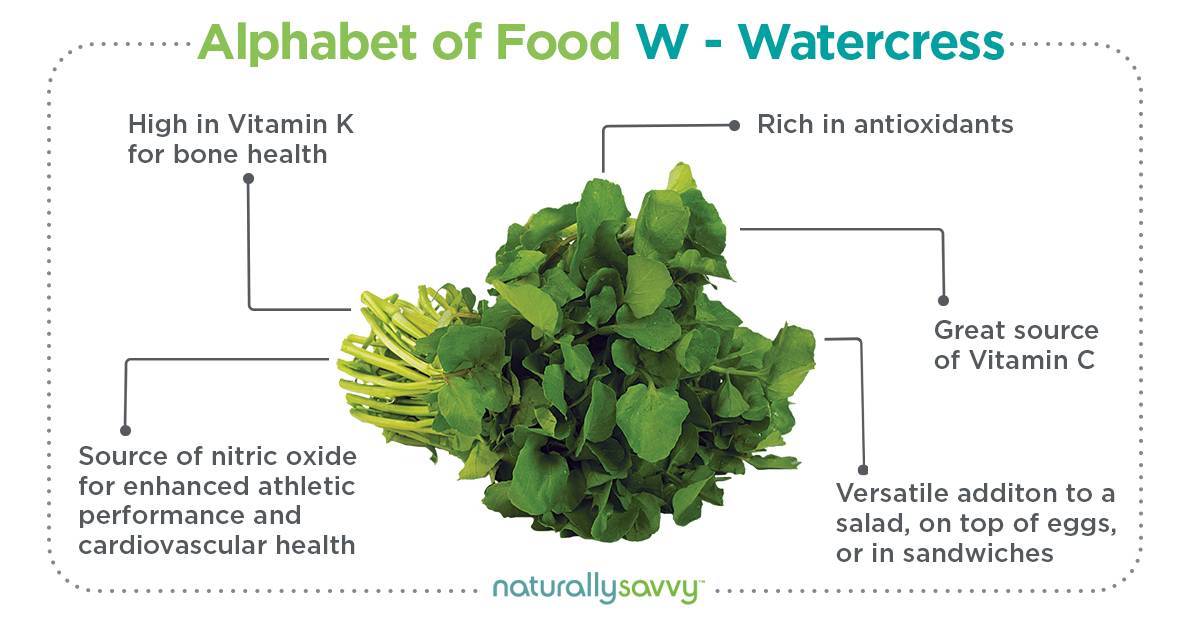
What do you think about watercress? If you are like many people, probably not much, and that’s too bad. Watercress is a powerhouse of nutrients and is actually the number one produce pick for nutrient density by the Centers for Disease Control and Prevention (CDC). A food’s nutrient density is determined by measuring the item’s vitamin, mineral, and phytonutrient content in relation to its caloric content.
In fact, greens dominate the top of the nutrient-density list from the CDC, with watercress followed by Chinese cabbage, chard, beet greens, spinach, chicory, leaf lettuce, parsley, romaine lettuce, and collard greens. Yet how many of us enjoy at least some of the other nine mentioned greens while ignoring the number one pick?
Read about six green vegetables to eat right now
As a vegan, I am a huge fan of vegetables, yet watercress has honored my plate only a few times in my lifetime. That’s about to change ever since I learned more about this incredible green.
What is watercress?
Watercress is a member of the cruciferous family of veggies, which also includes broccoli, cauliflower, cabbage, and kale, among others. Cruciferous vegetables are well known for their cancer-fighting abilities as well as battling oxidative stress (associated with chronic disease) and helping prevent cardiovascular problems.
Very young watercress has a slight peppery taste that grows stronger as the plant matures. It grows quickly in an aquatic or semi-aquatic environment and is a native of Europe and Asia.
Ancient peoples regarded watercress as an important food, especially Hippocrates, who treated patients with this vegetable. During more recent centuries, you may have heard about watercress sandwiches, which were considered a common food during the 19th century in England. Somehow the popularity of watercress faded, but its healthful values did not.
Read about whether vegetables are healthier raw or cooked
Watercress nutrition
Watercress gets the number one spot for nutrient density because of its high vitamin, mineral, and phytonutrient content when compared with its caloric content. In fact, one cup of watercress is a mere 4 calories, has 0 grams fat, and registers 0 on the glycemic load index while providing the following nutrients:
22% vitamin A
24% vitamin C
106% vitamin K
4% calcium
4% manganese
3% potassium
2% each vitamin E, thiamin, vitamin B6, riboflavin, magnesium, and phosphorus
1 gram protein
Health benefits of watercress
Watercress is an excellent source of nitrates, which have been show to lower blood pressure, boost athletic performance, and reduce the amount of oxygen you need while exercising when consumed in high amounts. One of the cancer-fighting compounds in cruciferous veggies, 3,3’-diindolylmethane (DIM), has demonstrated an ability to protect against cancer as well as guard healthy tissues during radiation treatment for the disease.
Bone health also can benefit from watercress. The excellent amounts of vitamin K in this vegetable can improve your bones by enhancing absorption of calcium, reducing excretion of calcium via urine, and modifying bone infrastructure.
The antioxidant alpha-lipoic acid also is found in healthy levels in watercress. Anyone who has diabetes or who is prediabetic can reap benefits from watercress, as this nutrient can enhance insulin sensitivity, lower glucose levels, and reduce diabetic neuropathy.

How to use more watercress
Watercress is likely more versatile than you think. Try one or more of these tips and the following recipes.
- Add a handful of watercress to your smoothies
- Mix watercress with other greens in your salads
- Add chopped watercress to omelets, stir-fries, pasta sauces, and dips
- Use instead of sprouts on sandwiches
Watercress Soup (serves 4)
1 tsp coconut oil
1 onion, diced
1 cups fresh or frozen peas
1 cup chopped celery
4 cups vegetable stock
1 cup fresh watercress, chopped
14 oz coconut milk
Pinch of salt and black pepper to taste
Melt the coconut oil in a large soup pot. Add the onion and celery and cook until soft. Add the vegetable stock and peas. Bring to a boil, lower the heat, and add the watercress, salt, and pepper. Cover and simmer for 5 minutes. Using a blender or hand mixer, puree the soup until smooth while you add the coconut milk.
Watercress Pesto
1 bunch watercress (about 5.5 cups), tough stems removed
¼ cup chopped walnuts
2 garlic cloves, chopped
3-5 tbs extra virgin olive oil
Zest of 1 lemon
In a food processor, pulse the watercress, pine nuts, lemon zest, and garlic until chopped coarsely. Add the oil slowly (you may not need 5 Tbs) and pulse again. Season with salt and black pepper. Serve with your favorite pasta, vegetables, bread, or other dishes.
References
Centers for Disease Control and Prevention. Defining powerhouse fruits and vegetables
Fan S et al. DIM (3,3’-diindolylmethane) confers protection against ionizing radiation by a unique mechanism. PNAS 2013 Oct 14
Han Y et al. Differential efficacy of methylcobalamin and alpha-lipoic acid treatment on negative and positive symptoms of (type 2) diabetic peripheral neuropathy. Minerva Endocrinology 2016 Nov 30
SELFNutritiondata.com. Watercress
Villa JK et al. Effect of vitamin K in bone metabolism and vascular calcification: a review of mechanisms of action and evidences. Critical Review in Food Science and Nutrition 2016 Jul 20










